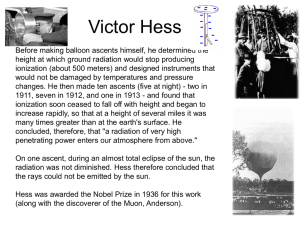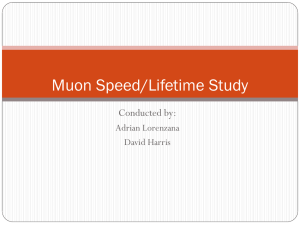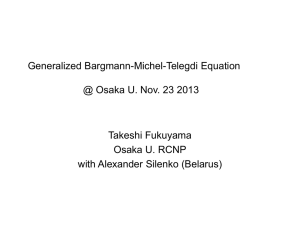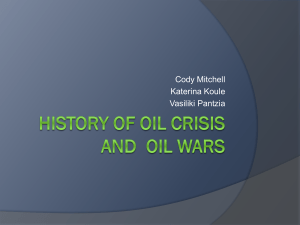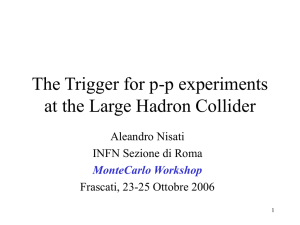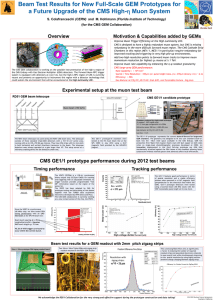Presentación de PowerPoint
advertisement
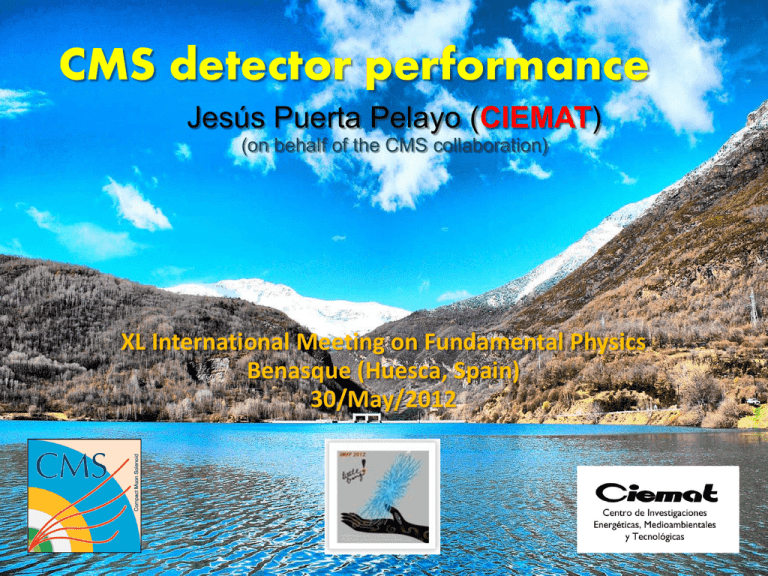
CMS detector performance Jesús Puerta Pelayo (CIEMAT) (on behalf of the CMS collaboration) XL International Meeting on Fundamental Physics Benasque (Huesca, Spain) 30/May/2012 Outline CMS in a glimpse CMS yesterday Design guidelines & assembly CMS today Subdetectors description & performance CMS tomorrow The CMS upgrade program in a glimpse General purpose LHC experiment Compact, hermetic, fully solenoidal design. All central tracking and calorimetry inside a superconducting solenoid (B=3.8T) Powerful external muon spectrometer 39 countries, 169 institutes, 3170 scientists and engineers (800 students) Fully operational since LHC start Almost 6 fb-1 collected at 7TeV 3.3 fb-1 at 8TeV in 2012 Many interesting physics results… AN OUTSTANDING MACHINE! CMS design guidelines High performance muon spectrometer & trigger system Very good muon identification and momentum measurement Trigger efficiently and measure sign of TeV muons dp/p < 10% High energy resolution electromagnetic calorimetry ~ 0.5% @ Et ~ 50 GeV Powerful inner tracking systems Momentum resolution a factor 10 better than at LEP Hermetic hadronic calorimeter Good missing ET resolution Above all, a powerful magnet to help measuring particles momenta Under construction (2000-2008) Detector assembly took place between 2000 and 2008 The idea of assembling the detector in several big pieces on the surface in parallel to infrastructure works in the cavern strongly influenced the CMS design, as it was built in “slices” that could be lowered with a special gantry From 2000 to 2006 preparation works in the cavern took place, in parallel to detector assembly on the surface hall & labs. Lowered, closed and ready for beam in September 2008 Several cosmic rays data taking campaigns with parts & full detector before the first collisions were CRUCIAL in order to commission the detectors, DAQ and trigger systems, calibration, alignment etc. The CMS subdetectors Momentum / charge of tracks and secondary vertices are measured in central tracker (Silicon layers). Energy and positions of electrons and photons measured in a high resolution electromagnetic calorimeter. (~ 0.5% @ ET ~ 50 GeV) Energy and position of hadrons and jets measured mainly in hadronic calorimeters. Muons identified and momentum measured in external muon spectrometer (+central tracker) dp/p<1% @ 100GeV and <10%@1 TeV Neutrinos identified and measured computing missing transverse energy in calorimeters (hermeticity = good missing transverse energy resolution) The inner tracker First experiment with full Si tracker system. Largest silicon detector ever built. Pixel detector for precise reconstruction of secondary vertices Strip Tracker with excellent tracking efficiency and resolution (Δp/p<1% @ 100GeV) Full coverage range |η|<2.4 • Pixel detector: 3 barrel layers, 2 disks each side ~ 2m2, 66 M channels (radius 4.3 - 10.2 cm) • Strip detector 10-12 barrel and endcap layers, 198m2, 9.3 M channels, (radius 20 - 116 cm) Tracking based on multiple iterations using combinatorial track finding Modules aligned up to O(10μm) accuracy Tracker performance Fraction of active detector: Pixel: 97.3% Strips: 97.8% Hit resolution depends on sensor thickness and strip pitch (the minimum value is reached for an angle corresponding to optimal charge sharing) Percentage of dead channels: 3.1% Single hit efficiency: >99.9% Strips: 15 μm to 45 μm Pixels: 9 μm to 35 μm Tracking performance For low momenta tracks, momentum resolution is driven by tracker performance. Resolution on transverse momentum measured using J/ψ mass line-shape. Sensitive to: • Knowledge of the tracker material • Alignment • B field • Reconstruction algorithms In general good agreement with MC (~5%, some deviation in the transition region of barrel to end cap). Primary vertex finding efficiency above 99.5% for >2 charged tracks. For PV with more than 10 tracks with average pT>1.2 GeV: close to 20 μm Particle ID in TK energy loss • Hit cluster charge proportional to energy deposit. • Calculated dE/dx along trajectory measurement using the silicon strips hits. • Particle identification possible up till 1 GeV. K p d Deuterons are missing in simulation K p d Electromagnetic Calorimeter High granularity, extremely good resolution, low noise, good uniformity/intercalibration Lead-tungstate (PbWO4) scintillating crystals optically coupled to Avalanche Photo-Diodes (Barrel) and Vacuum Photo-Triodes (Endcaps): • High density (ρ=8.3 g/cm3) • Short radiation length (X0=0.89 cm) • Small Molière radius (RM=2.2 cm) • Fast response (80% in 25 ns @ 425 nm) Radiation-hard (need transparency monitoring) Energy resolution: (~ 0.5% @ ET ~ 50 GeV) Two lead radiators (2 and 1 radiation lengths thick), each followed by a layer of Si microstrip detectors, instrument both Endcaps, acting as as preshower Calorimeters. ECAL performance Fraction of alive channels: • ECAL Barrel: 99.2% • ECAL Endcap: 98.7% • ECAL Preshower: 95.1% 2 complementary methods for crystal calibration: • φ-symmetry calibration: exploiting the energy-flow invariance around the beam axis in minimum bias events (for crystals at the same pseudo-rapidity) • π0/η calibration: mass constraint on di-photon events (inter-calibration and monitoring of energy scale) Systematic uncertainty is 0.6%(1.5%) for Barrel(Endcaps) (for electrons) Photon energy scale agrees with expectations: 1%(4%) level in Barrel(Endcaps) ECAL performance Radiation induces wavelength-dependent crystal light-transmission loss (w/o changes in scintillation) by few percent within a typical run, recovering during the inter-fill periods. Transparency correction needed Overall effect of single channel intercalibration and transparency Corrections on the Z -> ee invariant mass peak in the ECAL Barrel Stable energy scale was achieved throughout 2011 run after applying laser corrections Z⟶ee Energy resolution ECAL provides very good energy resolution down to low energies Performance in agreement with expectations At high ET the scale in the barrel region is now set by the π0 calibration (correct to 1%); 3% shift in the endcap region Good knowledge of material budget Photon & electron reconstruction TRIGGER: Electron and photon selection starts online • L1 e/γ trigger efficiency (nominal threshold: 15 GeV) for electrons from Z decays Di-electron invariant mass spectrum (2010 dataset) Resonances clearly visible Hadronic Calorimeters Compact & hermetic calorimeter, good segmentation and coverage (|η|<5.2) Sampling Calorimeter: Scintillator (active) & Brass (passive) Barrel: 2 half barrels,18 wedges of 20º in Phi each. Endcap: 2 plugs, 18 endcap wedges each 17 active plastic scintillator tiles / layers. Total 20916 tiles 1368 Megatiles (sheets of scintillator) Δη x Δφ = 0.087 x 0.087) Few additional layers, the outer barrel (HO), tail catcher sitting outside the coil, ensuring no energy leaks out the back of the HB undetected. 2 forward calorimeters (HF) positioned at either end of CMS, measuring high pseudorapidity range. (Steel absorbers with quarz fibers) Jet angular resolution ~ 20 (30) mrad in φ (θ) at ET ≥ 100 GeV HCAL performance HCAL sub-detector very stable over 2010-11 period with > 99% of HCAL channels live Gain corrections are based on LED monitoring. Phi-symmetry corrections are calculated with and without LED gain corrections. With LED corrections applied, 2011 phi calibration is close to 2010. Correction factor after imposing phi symmetry Isolated hadron response: By using isolated tracks, an eta-dependent energy correction to the data up to |η| ≤ 2.4 can be obtained Dedicated trigger selecting events with isolated tracks with PT>38GeV before corrections after corrections Particle Flow Alternative to «standard» energy reconstruction method: In CMS, charged particles get well separated due to the extense tracking volume and high magnetic field (3.8 T) CMS has an excellent tracking resolution, able to go to down to very low momenta (~few hundred MeVs) CMS has also an excellent electromagnetic calorimeter with good granularity in multi-jet events. Only 10% of the energy corresponds to neutral (stable) hadrons. Factor of two improvement in energy resolution with respect to measurements using calorimeter information only The muon system • • • • Efficient muon identification Precise muon pt measurement (improves tracker based results above 200-300 GeV/c) Provide effective standalone trigger capabilities ENDCAP BARREL Detectors interleaved with the magnet yoke steel layers Cathode Strip Chambers (CSC) used in endcaps (tracking detector / self triggering / performs bunch crossing id. / able cope with large rates magnetic filed inhomogeneities) 4 stations in the endcaps (0.9 < |η| < 2.4) Drift Tubes (DT) used in barrel (tracking detector / Resistive Plate Chambers (RPC) in barrel/endcaps (excellent timing resolution / mostly used for triggering self triggering / able to perform bunch crossing id.) 4 stations in the barrel (|η| < 1.2) Muon detector performance Individual performance of both tracking detectors well inside specifications Hit efficiency > 99%, resolution between 200 and 400 microns RPC: Good overall efficiency above 94% for properly working station both in barrel and endcaps Regional muon trigger Trigger primitive information (for DT and CSC) or single hits (for RPC) are used to reconstruct full muon tracks crossing the spectrometer. The BX identification is performed with very high efficiency. A coarse pt and position estimator is propagated to further trigger levels Transverse momentum measurement is critical as it is used later on (Global Trigger) to perform final accept/reject decision Muon reconstruction Muon Identification based on “tight” quality cuts applied to muon reconstructed by the Particle Flow (PF) algorithm similar to ones used for high pt analyses Relative Combined Isolation (rel. comb. iso.) computed by measuring neutral hadron + charged hadron + photon energy deposits in a cone around the μ and dividing by muon pt (rel. com. iso. cut applied in plot < 0.15) Efficiency estimated using Tag & Probe for PF muons passing tight selection criteria Muon objects The complete muon object is built using tracker tracks (TK muon)+ muon system tracks (Std Muon), in order to build a Global muon Muon detector performing remarkably Excellent resolution in the resonances Y(1,2,3S) CMS status (end 2011) 5.72 fb-1 delivered by LHC and 5.2 fb-1 recorded by CMS. Overall data taking efficiency ~91%. Average fraction of operational channels per subsystem >98.5%. Uncertainty on the luminosity determination 4%. CMS NOW! (2012 performance) After the winter shutdown, LHC started delivering new collisions at √s=8 TeV. So far LHC performance is remarkable. First stable beams delivered: 5/Apr/2012 β*=0.6m, Nb=47 bunches, 1.3 1011 p Peak lumi already exceeded 2011’s Expecting ∫Ldt ~16 fb-1 in 2012 Max day 2012 = 190 pb-1 (full 2010 = 43 pb-1) Pileup (the price to pay…) Real CMS event with 20 PVx … but still affordable… As instantaneous L increases, the number of interactions in a single crossing gets larger. In 2011 number of reconstructed vertices after the August Technical Stop increased by factor 1.5 (β*=1.5 m) Fills start with ~15 pile-up interactions CMS can deal with this: high granularity and relatively low occupancies Vertex reconstruction still quite linear with luminosity Triggers able to cope with this challenging data taking conditions Offline algorithms substract activity not coming from event primary vertex CMS tomorrow: The Upgrade program Why? LHC turned out to be able to deliver much more luminosity than foreseen -LHC operation plans go beyond 2030 -Finalize parts of the detector that were foreseen but not funded (forward muon) -Maintainability: substitute non optimal parts (HO photodetectors) -Maintain or if possible, improve detector performance (4th pixel layer, S/N calorimeter, longitudinal segmentation at HCAL, timing information) -Insure minimal degradation with time and with radiation (pixel, tracker replacement) LHC upgrade scenarios CMS (Phase 1) (2010-2021) CMS2 (Phase 2) (2021-2030?) The upgrade scenario PHASE 1 400 fb-1 in 10-12 years…. 4 TeV Splices, SEE Injectors (linac4?), collimation, crab cav HL Long Shutdowns PHASE 2 3000 fb-1 in 10-12 years…. Lpeak=1035 cm-2s-1 Pile-up 200@50 ns (100@25ns) Nominal LHC 1034 cm-2 s-1 25 ns 20 pile-up 7 TeV/beam Phase I highlights (I) Muon system -DT θ Trigger Board replacement (innermost station) -Relocation of SC out of the cavern (new ROS, new TSC, new DTTF) New external RPC endcap station New external CSC ring Improvement of innermost endcap muon station New beam pipe & pixel detector Higher efficiency (3/4) Lower trigger rates Recover trigger 2.4<n<2.1 Make it redundant? Features of the new detector: • 4 barrel layers (3) and 3 endcap disks (2) • Inner layer closer to IP • New readout chip with expanded buffers • Less material budget • CO2 two-phases cooling • DC-DC powering • New technology better radiation tolerance? 32 Phase I highlights (II) HCAL upgrades * HPDs had to be operated at low gain (decommissioned HO large noise in B field) *SiPM will allow -Longitudinal segmentation -Timing measurement for rejecting backgrounds -MIP detection Trigger & DAQ upgrades * Increase bandwidth (basically all systems will move from electrical to optical transmission) * Employment of new technologies (uTCA instead of VME): aim to redirect to ~standarized electronics (large FPGA, multiple optical inputs) * n-year replacement of computing equipment (PCs and networks), enlarge computers farms Conclusions • CMS detector has operated extremely well since 2008: • Millions of cosmic data have been collected in preparation for LHC startup at the end of 2009. • Since 2010 CMS has collected almost 5 fb-1 of integrated luminosity in pp collisions at 7 TeV, and over 3.3 fb-1 in 2012 at 8 TeV. • No major problems occurred during the two years of LHC pp & HI operation. • Detector performance is excellent, within expectations. • Extensive upgrade program already in progress • … and all this reflects in very precise and extraordinary tool for physics measurement, as you’ll see next… BACKUP CMS L1 Trigger L1 Muon trigger based on track segments in the three muon systems (DT, CSC, RPC) • Timing information used to match to the correct bunch crossing • HLT L2 refit of hits using full granularity and track reconstruction in regions of interest (defined in L1), momentum cut possible • HLT L3 Hit reconstruction in tracker, reconstruction from pixel seeds in regions compatible with L2 interest and primary vertex • Different muon trigger paths (single and double muon). • Single muon path pT at 3 GeV at startup. Allowed measuring inclusive beauty production in low momentum range. 16 Trigger requirements adapted to increasing luminosity. To keep the trigger rate within the devoted bandwidth an option is to devote a large fraction to non-prompt dimuon production. This will be the beneficial for B- and quarkonium physics. Level 1 Muon Trigger System RPC hits DT hits DT Local Trigger RPC Pattern Comparator (PAC) CSC hits segments CSC Local Trigger segments DT Regional Trigger CSC Track Finder ≤ 4 mu (barrel) + ≤ 4 mu (endcaps) ≤ 4 muons Calorimetric L1 Trigger e / photon / jets / Et / Etmis / Ht / MIP / ISO Global Trigger prog. combined logic L1 Trigger Accept Signal Global Muon Trigger ≤ 4 muons ≤ 4 muons b tagging b-Hadrons are produced in jets Displaced vertices due to long lifetime (1.5 ps) and Lorentz boost Clear signature Identification of semi-leptonic decays Low momentum (3 GeV) single muon trigger threshold at startup Probe inclusive beauty production at low momentum Inclusive reconstruction: Jet + Secondary vertex identification Exploit high precision of pixel tracker and long bhadron lifetimes Efficient reconstruction of secondary vertex for ET jet>20 GeV Excellent for b-jet studies at larger momenta Inclusive secondary vertex finder as a powerful tool for angular correlation studies, see talk on Tuesday by Ch. Grab b-Hadron exclusive identification Full reconstruction of the b-hadrons fourmomenta Competitive performance in Bd,c,s→ J/ψ X (J/ψ→μμ). b-Jet tagging works in a large transverse momentum range. • Uses excellent secondary vertex resolution from pixel detector • Between 50-60% tagging efficiency for pT~100 GeV with 0.1% background contamination
